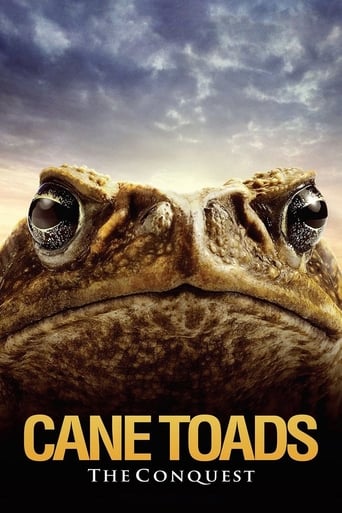MartinHafer
If you want to know about the infamous Cane Toad and its invasion of Australia, have I got a documentary for you! "Cane Toads: The Conquest" is wonderfully written, very interesting and has a nice sense of humor--exactly what the layperson would want in such a film. Sure, top-notch researchers from around the globe might not enjoy it as much because it is all 'sciency', but it is very well done and worth your time. The film follows the insane rationale behind the dreaded amphibian being deliberately released in the country as well as the inextricable spread of the creature. In addition, the film interviews lots of folks--some which hate the things and a few weirdos who actually think the Cane Toad is pretty neat (why, I have no idea). Overall, the show has a nice balance of humor, information and entertainment and it's well worth seeing.
eatfirst
A charming, oddball documentary that charts the progress of an invasive species of Central American toad across Northern Australia and the experiences of the townspeople it encounters along the way.Introduced to Queensland in the 1930s in an attempt to alleviate the blight of the cane beetle which was ravaging the crops of the regions' sugar cane farmers; the cane toad, in a manner all too painfully predictable, manifestly failed to live up to its billing as miracle cure for the farmers' ills, but rapidly became a fast spreading pest in its own right.Mark Lewis's film traces the history behind the original introduction, and then follows the invading force, mile by mile, and year by year, in its unstoppable march across the continent, whilst intercutting the stories of a cross-section of experts, officials, and shall we say... "locals" caught up in its path.If all this sounds like a job for the David Attenborough, that's understandable, but you'd be missing the point. There is real environmental science to be learned here, to be sure, but Cane Toads: The Conquest treads this ground lightly, offering an easily digestible sprinkling of facts that could comfortably be crammed into a fifteen minute PowerPoint session. What it delivers in spades is an understated, blackly comic mix of horror parody and absurdist social docu-drama as we meet the wonderful parade of folks who paint them, stuff them, pet them, curse them with Old Testament wrath and launch them from home made rockets!Sometimes fascinating, and frequently funny, this is less a film of amphibious analysis and more an affectionate portrait of Australians in all their eccentric glory.
gregking4
This fascinating, informative, slightly irreverent, thoroughly entertaining and engaging documentary is a belated follow up to Mark Lewis's 1988 documentary Cane Toads: An Unnatural History. Using archival footage, Lewis briefly retraces the history of this poisonous pest, which was originally introduced into Australia from Puerto Rica in the 1930's to combat the greyback beetle that was destroying sugar cane crops. The toads had been successful in Hawaii, but in Queensland they were a massive failure. Instead they became a massive problem for Queensland, an ecological nightmare for northern Australia. With their toxic secretions they are also a danger to domestic pets. And now with a breeding cycle that produces between 30,000 and 40,000 eggs twice every year, there are over 1.5 billion of them, and they seem indestructible. In the past 60 years they have spread across northern Australia in an inexorable march that now sees them. threaten Western Australia. Out of necessity much of the information presented here is essentially repeating material from the original film, although Lewis' stance towards the ugly creatures seems to have softened. However, what makes Cane Toads: The Conquest stand out from other wild life documentaries is its distinctive sense of humour. Lewis finds plenty of differing opinions on the cane toad, and he introduces us to a range of colourful characters, from scientists to self-aggrandising politicians to every day people. The talking heads interviews though are done with an exaggerated style in keeping with Lewis' tongue-in-cheek approach. Some of the anecdotes are very amusing. Monica Kraus, the happy little girl seen fondling her pet cane toad Dairy Queen returns all grown up and reminiscing about her friendship with a creature that many more vilify. One of the more fascinating characters he introduces this time is Kevin Ladynski, an entrepreneur who operated a traveling "toad show" featuring elaborate dioramas constructed with stuffed toads. Sadly he overestimated the appeal of the toads for the public and went broke! There are many laugh out loud moments and re-enactments, especially as Lewis depicts some novel ways for dealing with the virulent pest – from cricket bats to lawn mowers to sky rockets. The gorgeous cinematography of Kathryn Milliss, Paul Nichola and Toby Oliver captures the often harsh beauty of the landscapes, and enriches the film. Many shots are from the toad's point of view, giving us a more intimate insight. This is the first independently financed documentary to be shot in 3D. Unlike other films retrofitted for the process, here it actually adds to the marvellous visual style and is used effectively.

